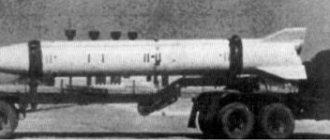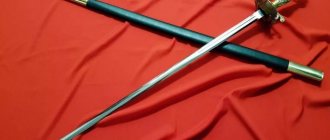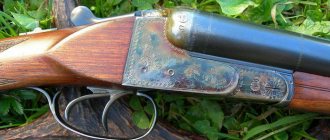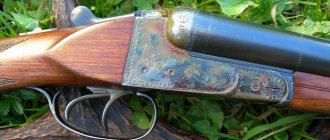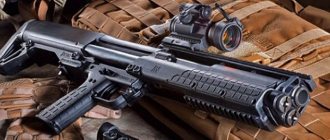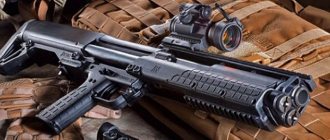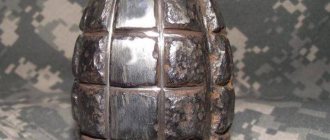Every man, especially those who served, will agree that military clothing is considered the key to the high combat effectiveness of military forces. In Russia, military uniforms always meet all the necessary requirements: they are reliable, comfortable and perform all their main functions. Today in Russia every soldier of the military forces is equipped with a military uniform. Still, uniforms are one of the important aspects of service.
Let's look at what tactical gloves are, what types there are, why they are needed, and why some people consider this accessory useful and others do not.
Hands are an indispensable human tool, but they can also be good weapons. If we didn't have fingers that function normally, using a pocket knife or reloading a crossbow would be a pipe dream. This is the reason for purchasing a good set of tactical gloves.
Knightly ancestress
The common prototype of all modern tactical gloves is medieval knight's gloves. In medieval tournaments, a knight, armed with a heavy seven-meter spear, galloped towards another knight at full speed to strike the enemy.
The knight held his spear in his right hand, dressed in a special “knight’s” glove, which was skillfully forged by ancient blacksmiths. It was built on the “fish scale” principle, consisted of many dozens of parts and was a complex engineering structure. From this magical fusion of technology and art grew all the current tactical heirs of the combat knight's glove: army, police, sports and glamorous modern tactical gloves.
Constant companions of knights
A sword with a cross-shaped handle is the main weapon of medieval warriors, which acted as a kind of symbol of chivalry. It was superior to other types of bladed weapons in terms of convenience and maneuverability. In experienced hands, a meter long sword, weighing about 2 kg, could be used with incredible efficiency. The pointed sword easily penetrated armor and cut off limbs.
Representatives of the military aristocracy, who showed themselves excellently in battles, received the right to name their weapons. In peacetime, it could even be carried in public places and used for self-defense.
By the 15th-16th centuries, a dagger was also a mandatory element of a combat costume. It was always placed to the left of the saddle. A shield was an indispensable assistant for protection from spears and blows of swords. Wooden products were covered with leather and covered with metal strips.
The constant companion of the medieval knight was his faithful horse. Armor was also used to protect strong, battle-trained animals. The armor, referred to as “bard”, included 5 main elements:
- krupper – to protect the torso;
- kritnet – for the neck;
- chanfron - for the head;
- peytral - for the chest;
- flanchard - for the sides.
A horse in an iron blanket, saddled by a knight dressed in armor, became a kind of fortress. Due to this, the rider and the animal were less vulnerable to being hit by arrows, as well as by blows from enemy swords and spears.
The 1.5 mm of metal covering the horse’s entire body area turned into colossal figures for the total weight of the “outfit.” The weight of horse armor varied between 30-45 kg. If you add up these numbers with the weight of the armored rider, it is easy to calculate that the horse had to carry 25% of its own weight.
Types of tactical gloves
Tactical Kevlar gloves, the so-called “brass knuckles,” are especially popular among military enthusiasts. Let's start with them.
Brass knuckles gloves
This name is due to the fact that the design contains elements of brass knuckles. Namely, plates shaped to the shape of the knuckles of a hand clenched into a fist, made of durable hard plastic, usually Kevlar.
These special inserts protect your knuckles from damage when hitting a hard asphalt surface or when punching an opponent in the jaw. Russia loves tactical Kevlar gloves as an essential attribute of real toughness. Black tactical combat gloves, the preferred material for which is leather, look better than khaki and camouflage. It is characterized by increased strength and resistance to external atmospheric and other influences, as well as environmental friendliness. The hand feels comfortable in a leather glove. That is why leather is often used in the manufacture of this accessory.
Rigid fixation on the wrist in this case is carried out by two Velcro. The presence of a reinforced block, which is responsible for the safety of the knuckles, is important not only from a functional point of view, but also from an aesthetic one. The block gives the accessory additional brutality.
The peculiarity of such gloves is that you can use gloves not even for physical, but for psychological influence on the enemy. Seeing the “brass knuckles” the enemy may fold.
Fingerless yachting gloves
In Russian, fingerless gloves are called “mittens.” Emphasis on "e". A beautiful Russian word of French origin denotes an item of women's clothing, including one made of lace.
Proponents of the military style do not know this. They call it “tactical gloves with cut off fingers.”
Mittens, mostly suede, are very necessary for yachtsmen. In the race, athletes spend hours hauling kilometers of halyards, nyrals, sheets and other running rigging. If the hands of inexperienced yachtsmen are not protected, their palms will become covered with bloody calluses. Yachting mitts feature real or synthetic suede on the palms and fingers for maximum palm protection. Velcro, which secures any mitt on the hand, makes operation as convenient as possible. Damage to the skin can be minimal, especially when the mitt is tightly and comfortably fixed on the hand. In this case, the attachment to the hand is carried out with two Velcro. Careful palm protection makes working with the rigging of a sailing yacht much easier. Yacht mitts provide a secure and comfortable grip on the rigging and helm. The most popular variations of gloves used for yachting manage to provide good additional protection and excellent resistance to various negative factors. Yacht mitts are light, durable and fit the hand well.
Bicycle mitts
Among the supporters of the military style there are many cyclists. They often ride bicycles wearing mitts, which protect their palms but leave their fingers exposed. The problems of cyclists are similar to those of yachtsmen. Their palms also need protection.
Bicycle mitts are easy to use; your palm confidently holds the handlebars and brakes. A better grip is facilitated by the presence of inserts made of artificial leather or synthetic textiles. The manufacturer often resorts to the use of perforations to ventilate and drain sweat from these gloves in addition to the natural permeability of suede or textiles.
The mitts are secured with Velcro. They are resistant to various adverse influences: this is achieved through the use of modern synthetics. When using polyester, when part of the product is made of modern synthetic polymer, the mitt turns out to be very light.
There are known cases of using reinforced pads on bicycle mitts, which are responsible for the safety of the knuckles, for example, when falling from a bicycle. If it were possible to increase the weight of the equipment and equip road cyclists with elbow and knee pads made using the same technology, then there would be significantly fewer serious injuries in the rubble of road cycling races. But victory requires sacrifice, and cyclists are equipped only with mittens.
Biathletes' equipment
Biathletes compete in frosty weather, at sub-zero temperatures. They have to find an acceptable compromise between the desire to have a tactile sensation of hand contact with the rifle and the need to keep the hand warm. You won’t warm your hands from the fire of a shot, so to reach a compromise, many biathletes use a folding case that covers the last phalanx of the index finger. At a distance, the finger is in a warm cover, and when approaching the firing line, the biathlete throws back the cover and places his bare finger, not protected from the cold, on the trigger. This technique allows you to subsequently achieve maximum sensitivity of the index finger when pressing the trigger.
In general, insulated accessories are not prohibited and are widely used by athletes. You just need to take the ergonomics into account properly. Thus, good contact of the glove with the weapon prevents the hand from sliding along the rifle stock. Between the thumb and index finger is the point of contact between the shooter's hand and the weapon. Convenience in this area ensures comfortable aiming.
To a large extent, the material used to keep the athlete's hand warm determines the work with the weapon. It is necessary to use the thinnest, but very warm synthetic polymer fabric. This material should warm the hand and provide complete, reliable protection for the palm and entire hand from any temperature. For effective weapon handling, the material used to warm the shooter's hand is especially important: it ensures the strength of the product and comfortable conditions for shooting.
Popular brands
Cycling gloves produced by leading brands have a stylish design, a comfortable fit and good air permeability. They will prevent your hand from slipping off the steering wheel and partially reduce unpleasant vibrations during intense riding.
Below are the brands that have gained the highest popularity among athletes and cycling enthusiasts.
Fox. Cycling gloves from this company are rightfully considered one of the best. They are presented in a wide range and in different price ranges. A big advantage is the variety of models for children and teenagers, taking into account the characteristics of the age-related structure of the hand. In summer versions, the outer side is made of perforated fabrics, which ensures good air flow. The inter-toe compartments feature easily stretchable knit inserts that provide maximum comfort.
How to choose tactical gloves?
Choosing a pair of tactical gloves can be quite a daunting process. There are several aspects that need to be taken into account. Do you want a pair of gloves that will:
- Protect you from cuts and scrapes?
- Do not interfere with the ease of working with weapons?
- Keep your hands warm but still breathable?
It may sound dramatic, but the right pair of gloves can literally be as vital a piece of equipment as body armor. Therefore, it is very important to carefully consider all the options and have a clear idea of what tasks you need gloves for, rather than settling for a pair of inexpensive gloves.
On that note, keep in mind that you get what you pay for, and most decent pairs of gloves range in price from $30 to $150 per pair.
Besides price, what should you look for when choosing the right pair of tactical gloves for law enforcement work, for example?
Popular manufacturers
You can buy the best tactical gloves for any purpose (and not necessarily black) on the Internet. All major manufacturers constantly sell their products online. Of the foreign suppliers, the Polish company Helikon-tex deserves attention. It is the official supplier of equipment for the forces of the North Atlantic Alliance. Among the assortment, the Urban Tactical Line stands out, and ordinary consumers often buy these products.
Fans of American products should take a closer look at the 5.11 brand. The main line of this manufacturer is based on a model that was once supplied to the US police. The material has been carefully selected for the pads of the thumbs, and therefore you can freely work with smartphone screens, especially with walkie-talkies. BlackHawk SOLAG Spec is an equally legendary brand. Modern synthetics guarantee an acceptable feel and optimal grip even on wet surfaces.
Another large manufacturer is Oakley (California). It was this manufacturer who, before others, came up with a special “brass knuckles” design. It is worth considering that today Oakley is counterfeited by dozens and hundreds of companies in different countries. And the vast majority of illegal copies are of very low quality. The only difference is in price, and almost an order of magnitude.
It is also worth taking a closer look at the gloves:
- Mechanix Wear;
- Hatch NS430 Specialist;
- IHD Glove Helikon-Tex (features an excellent combination of design and functionality);
- Softshell Hendshuhe Glove Mil-Tec (suitable for ambulances and surgeons);
- Buff Original;
- Petzl;
- Ursus.
Find the right fit
The first and perhaps the most important factor. When you try on a pair of gloves, ideally, of course, take your sidearm with you and notice how it feels to handle the gun, knife, radio, handcuffs and other tools you use most often. Since not everyone owns a personal weapon, and taking your service weapon to the store is not the best option, ask the store for a model that is at least similar in size and weight.
The way your gloves fit and perform on your equipment is often very different from how they perform when you simply put them on for a fitting.
Main classification - by purpose
Models for daily use, depending on the season, can be made from various materials:
Knitted
They go well with a sports jacket, leather ones will look good with a coat. Fur models are considered an excellent option for the cold winter months.
Both women's and men's models are made for everyday wear. Men are recommended to have at least 2 pairs of such accessories: black and brown.
Evening gloves
Usually worn with a sophisticated evening dress as an addition to the toilet. Such accessories are usually made from velvet, satin, silk, guipure and lace.
Men's evening gloves are worn with a formal suit.
Fingerless "mitts"
Such models are more distinguished than others by their diversity and original design solutions. Mittens can be fastened with rivets, straps or a zipper.
Such accessories are worn when you want to demonstrate a spectacular manicure or attract the attention of others.
Children's gloves
Available in a variety of fun designs. Glove models in the shape of cat paws are very popular.
Such products will reliably warm a child’s hands in cold weather and cheer him up thanks to their funny appearance.
Sports
Used for martial arts, boxing, hockey, baseball and cycling.
Options for boxing are divided into professional, amateur, combat, training and projectile.
Hockey gloves are used to protect the wrist joints and lower parts of the forearms of hockey players from impacts with the puck and stick, or when falling on the ice.
Driving gloves
These models help your hands not slip off the steering wheel in hot weather, and in winter they reliably protect you from the cold. Products of this kind should have holes for air ventilation and a soft inner side that feels like suede.
Medical gloves
Depending on the intended purpose, medical models can be observation or surgical. The viewing rooms are made exclusively flat, and a characteristic feature of the surgical ones is their special anatomical shape.
Gloves used in medicine are usually divided into the following types:
- dental (have a fully or partially textured surface in the finger area for maximum comfort when using instruments);
- gynecological (have an anatomical shape and an elongated gaiter, sometimes reaching a length of 550 mm);
- surgical (made from latex, nitrile or neoprene);
- diagnostic (flat products used during examinations and minor operations);
- orthopedic (high-strength latex products that provide special tactile sensitivity);
- polyethylene (designed to protect hands from exposure to chemicals and water);
- chainmail (used during operations and procedures with patients infected with AIDS, HIV and hepatitis A, B, C).
Work gloves
are used to protect hands from various types of negative influences and vary depending on working conditions. Modern manufacturers offer a variety of options for any occasion.
Classification of work gloves
From mechanical damage:
- uncoated cotton, used for particularly precise work;
- knitted products coated with PVC, having dot inclusions that provide an increased level of strength (used in almost all industries).
Universal against chemical protection:
- smooth or rough latex products that are resistant to mechanical damage and are often used when working with slaked lime, in soap making, as well as in other industries;
- nitrile - elastic products that protect against cuts, burns and other possible damage;
- neoprene - impermeable to moisture and gases, used to protect against the harmful effects of various chemicals;
- disposable - thin products that protect hands from chemical exposure.
Increased strength:
- split leather - rough leather products that have good breathability and resist punctures, impacts and high temperatures;
- Gaiters are two-fingered, three-fingered or five-fingered products used in heavy industry that can withstand punctures, impacts, sparks and splashes of hot metal (made from tarpaulin, leather or split wood).
When choosing products of this kind, it is recommended to pay special attention to their quality. High-quality and correctly sized items should not cause a feeling of discomfort when used
Waterproof gloves
Unfortunately, waterproof gloves tend to reduce your dexterity and sensitivity to small parts. Different membranes increase the volume of the glove, which means that you can lose sensitivity, which is very important not only when working with weapons but also with various equipment. However, the trade-off may be worth it if you work in often harsh climates where you need better protection from wind, rain and moisture. It’s easier to get the hang of handling with uncomfortable gloves than to try to pull the trigger with fingers blue from the cold.
Puncture protection
When performing a search or personal search of a suspect, you are always at risk of coming across something that can cut, scratch, pierce or pierce your skin - knives, needles, glass and other hidden objects.
If your job duties put you in such situations, you should definitely look for tactical gloves that offer puncture resistance. They are generally less bulky than other line of defense gloves and still offer a reasonable degree of protection from the elements mentioned above.
Varieties
Cycling gloves come in different types and can be tailored to suit the weather conditions and riding style. They differ in air permeability properties and degree of protection. The male and female versions are not very different from each other in appearance (the only difference is the color scheme).
Cycling gloves are divided into types described below.
Mitts (without fingers). Summer option, ideal for use in warm weather. Made from breathable protective material that covers only the palms, leaving the fingers completely open. Your hands don't sweat, but gloves don't provide effective protection in case of a fall. This option is more suitable for riding on city roads.
